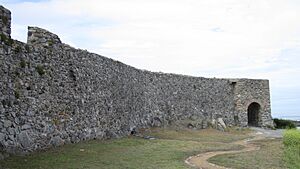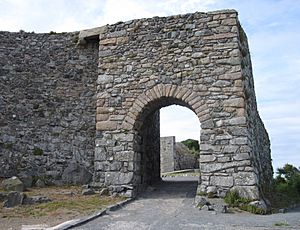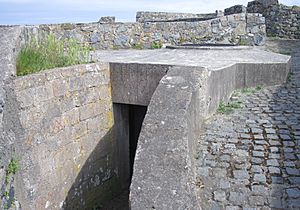Vale Castle, Guernsey facts for kids
Vale Castle is an ancient fortress located in the Vale, Guernsey. It's over 1,000 years old! This castle was built to protect the harbors of St. Sampson and Bordeaux. Its old names were "Le Château St Michel" and "Château de Val".
Contents
A Look Back in Time
Long ago, the northern part of Guernsey was separated from the rest of the island by a tidal channel. This means water would flow in and out, making it an island at high tide.
Ancient Beginnings
Even before the castle, people lived here. Around 500 to 600 BC, during the Iron Age, there was a fort on this very hill. It had two ditches and banks built into the earth. This shows it was an important defensive spot for a very long time.
The Middle Ages
Around the year 968, monks from a famous monastery called Mont Saint-Michel came to Guernsey. They started a religious community in the north of the island.
A story says that in 1032, Robert II, Duke of Normandy (who was the father of William the Conqueror) was on his way to England. He had to stop in Guernsey because of bad weather. He gave land, now called Clos du Valle, to these monks.
Later, in 1061, pirates attacked and robbed the island. The people asked Duke William for help. He sent a man named Sampson D'Anneville. With the help of the monks, Sampson drove the pirates away. As a reward, Sampson and the monks were given half of the island. The monks' part was called Le Fief St Michel. This land included the spot where Vale Castle now stands. The castle was built to keep people safe from pirates.
We don't know exactly when the medieval parts of the castle were started. It might have been in the late 900s. In 1338, during a naval war in the English Channel naval campaign (1338–1339), French forces captured Guernsey and then the castle. They killed the defenders. But the French left in 1340 after their navy was badly damaged in the Battle of Sluys.
In 1372, a Welsh leader named Owain Lawgoch attacked Guernsey with French support. This attack was known as “La Descente des Aragousais.” Owain Lawgoch left after killing 400 local soldiers. A poem about this event calls the castle Château de l'Archange. This was where the islanders made their last stand.
Early Modern Times
In the 1400s, strong granite walls and a gatehouse were added to the castle. Over the next 100 years, more repairs and improvements were made. A place to store gunpowder, a guardroom, and houses for the soldiers were also built. The castle even had its own well for water. By 1615, the people of Guernsey were responsible for maintaining Vale Castle. The Crown (the king or queen) maintained Castle Cornet.
During the English Civil War, which lasted nine years, soldiers who supported Parliament might have been based at Vale Castle. This was because Castle Cornet supported the King, while Guernsey supported Parliament. In 1680, major repairs were suggested for the castle.
Recent History
When the American Revolutionary War made France an enemy, barracks (buildings for soldiers) and other improvements were added to the castle. The French Revolution also posed a threat. So, the castle received powerful cannons: one 24-pounder and two 9-pounder guns.
The castle was fitted with a signal mast. This was used to alert the island when ships were approaching. At night, a fire beacon would be lit to give the alarm.
In 1799, 6,000 Russian soldiers stayed at nearby Delancey. Sadly, hundreds of them died from disease. You can find graves of Russian soldiers near Vale Castle.
During the Napoleonic Wars, the Braye du Valle was reclaimed from the sea between 1806 and 1808. This meant the Clos du Valle was no longer a tidal island. This made it easier to move troops and protect the island. The nearby port of St Sampson also grew with more trade.
During World War I, a small group of local soldiers stayed at the castle. Between the two World Wars, the barracks were used as homes by the local government.
The last changes to the castle were made by German workers in 1942–44. This was during the German occupation of the Channel Islands. They tore down the old barracks. In their place, they built four concrete machine-gun positions. They also added three mortar positions, trenches, four small bunkers called "tobruk pits," and shelters for soldiers. The German defenses at Vale Castle also included flamethrowers, two large searchlights, and two 10.5cm field guns.
Castle Design
Vale Castle has an unusual shape because it follows the hill it sits on. It is built with six round towers connected by strong walls. It also has a square gatehouse.
The sea is to the south and east of the castle. To the west, there used to be low, marshy land.
Uncovering the Past
Underneath the medieval outer bank, archaeologists found a small turf bank. This bank contained pottery from 500-600 BC. Similar pottery was found in a second bank under 14th-century military buildings inside the walls. This type of hillfort, with its double-bank, is special and unique in Guernsey.
Large digs took place in 1980. These showed that the original medieval parts of the castle were built around 1370–1400.
Protecting the Castle
The entire Chateau de Marais (Vale Castle) was officially listed as a Protected Monument on March 26, 1938. This means it is a very important historical site that must be preserved.
Vale Castle in Art
Many artists have been inspired by Vale Castle:
- Francis Grose (1731-1791) made an engraved print of St.Michael's, or the Vale Castle in 1786.
- Robert Mudie (1777-1842) included a print of the castle in his 1840 book, Historical and Topographical Description of the Channel Islands.
- Joseph Mallord William Turner (1775-1851), a famous painter, sketched the castle.
- Victor Hugo (1802-1885), a famous writer, mentioned Vale Castle in his 1866 book Toilers of the Sea.
- Edwin Hayes, R.H.A., R.I., R.O.I. (1819-1904), painted Vale Castle/Guernsey E Hayes Buscoe House/Stedes Rd.
Visiting Vale Castle
Vale Castle is open for everyone to visit! You can walk around the castle for free, unless there's a special event happening. There's free parking available at Bordeaux or off Castle Road.
The castle is now a popular spot for music festivals and private parties. The Vale Earth Fair music festival has been held here for over 40 years.
Visitors can also walk through the German trenches from World War II. You can see the "Tobruk pits," machine gun positions, and soldier shelters.
Gallery









